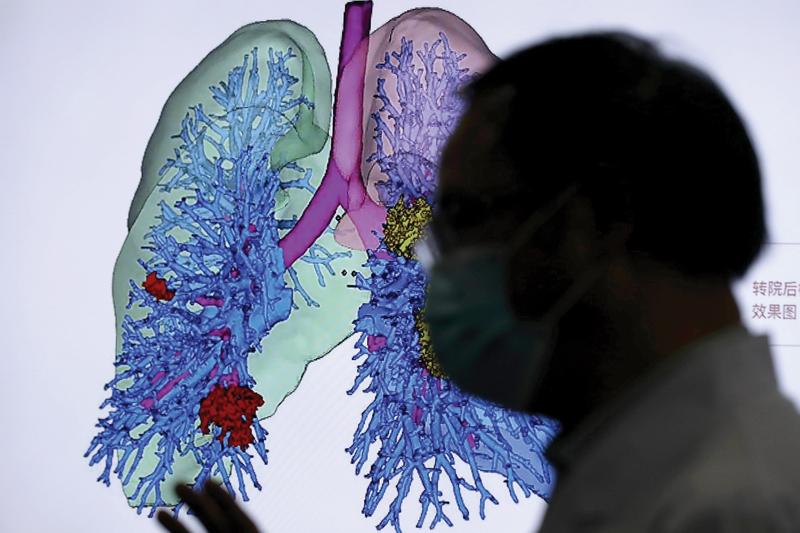Outbreak brings new opportunities for China’s burgeoning digital economy
 (LI MIN / CHINA DAILY)
(LI MIN / CHINA DAILY)
Wang Jiayi, a 31-year-old fashion magazine editor in the Tongzhou district of Beijing, is relying on a vending machine powered by artificial intelligence at her residential compound to supply her with fresh fruit, vegetables and other necessities.
“I select products displayed on the transparent door of the machine and use my mobile to scan a quick-response code,” Wang said.
“Once it is scanned, the door opens and payment is processed automatically after I make my selection and close the door,” Wang said.
The entire process is convenient and requires no human-to-human contact, she added.
The AI vending machines, developed by e-commerce giant JD’s logistics innovation laboratory, are being rolled out in Beijing, Shanghai and Chongqing due to the rising demand for unmanned shopping experiences amid the novel coronavirus pneumonia outbreak.
JD said the products sold by the machines are sourced from its fresh food supermarkets 7Fresh. Employees at the supermarkets regularly clean and disinfect the machines, monitor the quality and quantity of produce and ensure that supplies are fresh.
Since the outbreak emerged in China, state-of-the-art technologies, including fifth-generation wireless technology (5G), artificial intelligence, big data analysis, robots, cloud computing and drones, have been used widely not only in people’s daily lives but also in the fight against the pandemic.
The application of such technologies in controlling the outbreak stems from China’s long-time, massive input into their research and development, with the country a world leader in these fields.
President Xi Jinping has stressed that the use of digital technologies such as big data, AI and cloud computing must be encouraged to enable them to serve as a “pillar” in monitoring and analyzing disease outbreaks, tracing viruses, controlling and preventing epidemics, and in medical treatment and distribution of resources.
On March 4, a meeting of the Standing Committee of the Political Bureau of the Communist Party of China Central Committee emphasized that the country would accelerate the construction of new infrastructure, such as 5G networks and data centers.
Market research company International Data Corp has forecast that the outbreak will bring opportunities for 5G applications, remote offices and online activities, unmanned commerce and services, fresh food e-commerce and online education.
 An AI robot is used to disinfect the makeshift Fangcang hospital in Wuhan, Hubei province. (XIONG QI / XINHUA)
An AI robot is used to disinfect the makeshift Fangcang hospital in Wuhan, Hubei province. (XIONG QI / XINHUA)
With the outbreak preventing many people from returning to work and living a normal life, high-tech enterprises have been quick to develop targeted AI and 5G-enabled solutions for different virus control scenarios, providing frontline workers with more flexibility and convenience.
Remote healthcare services powered by 5G are among the most eye-catching applications, with the three major telecom carriers, China Mobile, China Unicom and China Telecom, providing strong technological support to ensure quality communication services among hospitals in different regions.
For example, on Feb 27, doctors in Beijing, Shanghai and Guangzhou, capital of Guangdong province, used 5G technology to treat a severely ill 67-year-old patient in Wuhan, the outbreak’s epicenter and capital of Hubei province.
By using the network’s superfast speed, large-size medical photos and videos can be shared quickly among doctors in different areas of the country, enabling them to formulate the best options for treatment.
Lyu Tingjie, a communications professor at Beijing University of Posts and Telecommunications, said: “Although remote medical services existed before the commercial use of 5G, this network has solved problems such as video lag and remote control delay experienced under the 4G network, ensuring a nearly real-time operation.”
Wang Zhiqin, deputy head of the China Academy of Information and Communications Technology, a government think tank, said China is entering a critical period of 5G network construction, with more than 550,000 new base stations expected to start operating by the end of this year.
On the front line of the battle against the virus, smart robots powered by 5G technologies are working with medics in Shenzhen, Guangdong.
Developed by Chinese AI pioneer UBTech, these robots are being used throughout the Third People’s Hospital of Shenzhen to offer medical advice, deliver drugs and disinfect wards and other areas. They can also check patients’ temperature and perform a range of repetitive work.
Liu Yue, head of the hospital’s fever outpatient services, said a robot equipped with an AI-enabled fever-screening system can take the temperature of 200 people in just one minute. “It greatly reduces our burden, and its wide scope can prevent us from missing infected patients,” Liu added.
Similar 5G-powered robots are also being used in Hubei, Shanghai, Beijing and other regions as part of broader efforts by the nation’s tech companies to use cutting-edge technologies to fight the outbreak.
Xiang Ligang, director-general of the Information Consumption Alliance, a telecom industry association, said the outbreak can inject new development momentum into China’s digital economy in the long run by promoting the transformation of a large number of traditional industries.
The technological prowess, quick response and resilience shown by Chinese tech companies appear to suggest that the pandemic could be a key point for emerging technologies, just as the outbreak of severe acute respiratory syndrome, or SARS, in 2003 triggered an e-commerce “explosion” in the country, he said.
Tencent and Alibaba have seen the use of telecommuting tools such as videoconferences and online office kits surge, as tens of millions of white-collar employees work from home to avoid cross-infection and curb the spread of the virus.
With stringent supervision of large-scale population flows critical to preventing the spread of the virus, these two tech giants are also lending a helping hand in community management.
They have introduced electronic exit and entry systems for residential compounds, allowing property management teams to keep precise track of people entering and leaving neighborhoods, including the time of arrival and departure, length of stay and health status.
 Doctors at different hospitals in Kunming, Yunnan province, use augmented reality and 5G technologies to discuss a case of novel coronavirus pneumonia infection. (HAO YAXIN / FOR CHINA DAILY)
Doctors at different hospitals in Kunming, Yunnan province, use augmented reality and 5G technologies to discuss a case of novel coronavirus pneumonia infection. (HAO YAXIN / FOR CHINA DAILY)
As more companies resume production, WeChat and Alipay have launched a health QR code system with links to residents’ health status and recent travel history. The system is being used at travel checkpoints, such as railway stations and highways, and also at community level.
Tong Taosang, senior executive vice-president of Tencent and president of the Cloud and Smart Industries Group, said the system aims to provide the government with a better view of people’s health status during the outbreak, as well as offering new ideas for pushing forward the digitalization of public governance.
“So far, it has covered more than 700 million people nationwide, and over 100 cities are preparing to launch the health code system,” Tong said.
He added that the company has also applied its cloud computing capacity and AI-enabled technologies to various industrial platforms and production processes.
Prompt information, including the location of traffic control areas, designated hospitals and infected cases, is being provided by Baidu Maps to help users cope with the outbreak. By using big data analysis, the company tracks population movements and predicts the spread of the outbreak nationwide.
Shoppers are steering clear of bricks-and-mortar stores and switching to online purchasing, with e-commerce platforms that deliver daily necessities and fresh produce witnessing a significant increase in business.
Raymond Wang, partner at global consultancy Roland Berger, said: “The outbreak has further proved the importance of the internet and digital economy. For example, the e-commerce and online-to-offline, or O2O, business model has solved people’s daily requirements, while the traditional retail industry has taken a big hit.”
Wang said that in the medium and long term, the outbreak would enhance social efficiency and result in a higher access rate for the burgeoning digital economy in terms of O2O, remote working and online education. “This is also a big opportunity for China’s technology and business model innovation — the foundations of the digital economy,” he added.
Many Chinese AI companies have tweaked algorithms and upgraded gadgets, systems and technologies in a variety of ways to specifically adapt them to fight the virus.
DJI, the world’s largest commercial drone manufacturer by market share, has used its agricultural devices to spray disinfectant in residential areas, hospitals and waste treatment plants. To date, the drones have sprayed disinfectant over 600 million square meters nationwide.
Zhang Jiaxing, an AI expert, said people are increasingly adapting to new lifestyles.
As a result, online education, working remotely and robot deliveries that are backed by cutting-edge technologies, such as the internet of things, big data and cloud computing, have been a significant boost and are expected to maintain growth momentum when the outbreak ends.
Contact the writers at fanfeifei@chinadaily.com.cn


